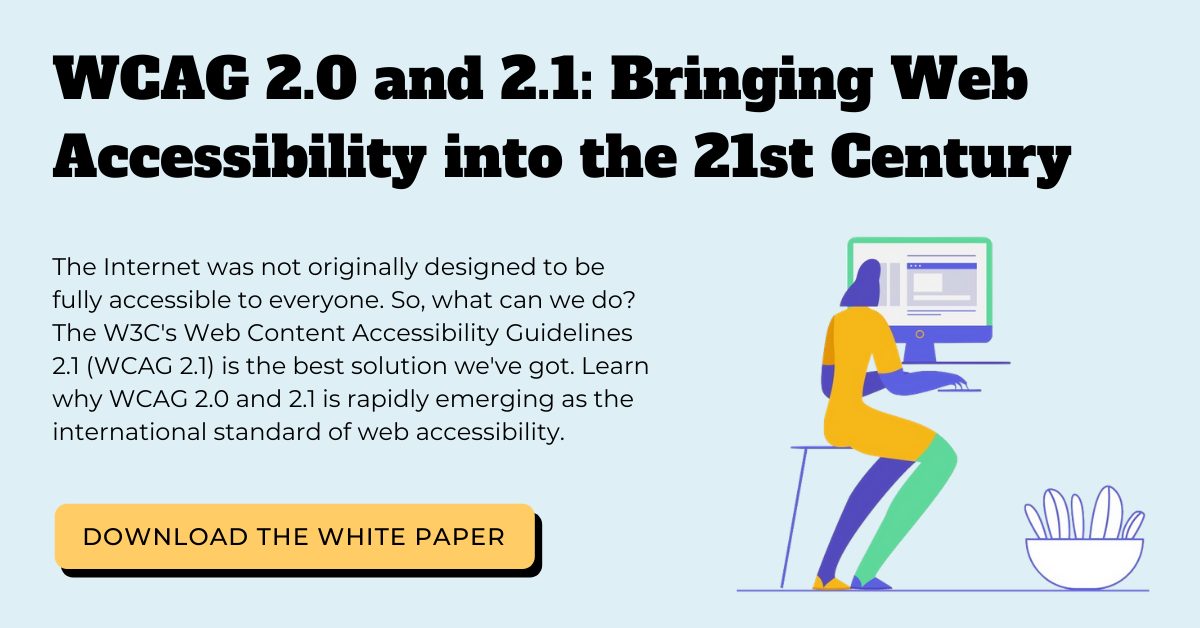How to Bake-In Website Accessibility
Updated: October 14, 2021
Everybody loves cake. However, you need to bake it with the right ingredients so that everyone can eat and enjoy it. Think of a website like a cake. Organizations can bake-in website accessibility and use the right web design “ingredients” to ensure that everyone has access to their web content.
Baking in accessibility is essential when designing or introducing new digital technologies like websites and interactive media such as video or LMS platforms. Organizations must consider the needs of people with disabilities as part of the initial design, procurement, or development process. Otherwise, they risk presenting significant access barriers instead of equal access.
It’s easier to bake-in accessibility if your organization plans ahead, incorporates accessible design from the start, and keeps accessibility at the forefront of the design process.
What Does It Mean to Bake-In Website Accessibility?
Baking accessibility in means being proactive rather than reactive. So, if your company puts a public-facing marketing video on its website, baking in accessibility means ensuring it has accurate closed captions and a keyboard accessible video player before being published.
Bake-In Website Accessibility
“To bake-in accessibility” is a commonly used phrase among web accessibility advocates. It means that organizations design, develop, or otherwise acquire accessible services and products with the needs of people with disabilities in mind from start to finish.
In terms of web accessibility, other examples of being proactive are having a web accessibility policy, budgeting for continued accessibility endeavors like video captioning, or including accessibility requirements on a procurement checklist.
How To Bake-In Accessibility
Below are some ideas, tips, and strategies used by different organizations to help foster a sustainable culture of accessibility and ensure internal and public-facing technology has accessibility “baked-in” from the start.
1. Budgeting Tips
It’s often challenging to go all-in on web accessibility unless your organization invests the required resources, such as budgeting and dedicated teams.
Sources of Grants and Funding for Closed Captioning of Online Video
In this brief, we have compiled some resources for grants and awards that can be applied to closed captioning.
Tuition Fees and Grants
In higher education, one way to obtain a larger budget to bake-in accessibility is through built-in student tuition fees that help fund an accessibility initiative grant. The University of Arizona used this strategy to fund a grant for buying accessible technology on their campus.
Dedicating a Budget to Accessibility
Setting aside a budget for anticipated accessibility needs is a great way to sustain an organization’s commitment to bake-in accessibility. Again, at the University of Arizona, a significant accessibility initiative is funded by the institution and managed by the Disability Resources Center for video captioning, transcription, and interpreters.
2. Organizational Tips
Below are several tips to help you manage and stay on top of your proactive accessibility endeavors.
Write an Accessibility Policy
If your goal is to bake-in accessibility, writing an accessibility policy and statement is a great place to start. Think of this as your organization’s accessibility law or accessibility constitution.
Having all the applicable legal requirements in one concise document, in terms everyone at the organization can understand, is crucial to maintaining a culture of inclusion. The process of designing or revamping accessibility at your organization is also educational to everyone involved. For information on developing a policy for your organization, reference the World Wide Web Consortium’s guide.
Build a Procurement Checklist
Before your organization implements a new system-wide software or technology, it should meet the standards for accessibility set by your organization’s accessibility policy and governing laws that implicate your organization.
Keep an eye out for upcoming contract renewals and write specific accessibility requirements into the renewal agreement. Rob Eveleigh, Five College Electronic and Information Technology Accessibility Coordinator for the 5 College Consortium of Western Massachusetts, suggests conducting a contract inventory or audit to see when those renewals are coming up so you can include those requirements in new contracts.
3. Ongoing Success Tips
To help ensure a culture of proactive accessibility is sustained successfully at your organization, keep sponsorship and testing in mind:
10 Tips for Making Web Video Accessible
This white paper is designed to equip you with the knowledge and current best practices necessary to make your web videos accessible to all users.
Executive Sponsorship
While grass-roots, bottom-up efforts are often needed for accessibility to take-off at an organization, top-down sponsorship from a CEO, president, or another form of executive leadership can ensure things get done and sustain.
If you work at a university, Rob Eveleigh also says to get the president’s office to sign a charge, or an executive order, to put together an accessibility team, form a budget, or implement new accessibility measures. Faculty and other departments are much more likely to cooperate if you have support from the top-down and a charge to prove it.
Rob Carr, the Accessibility Coordinator at Oklahoma Able Tech, says, “When these efforts begin grassroots and kind of stay grassroots, I think you’re more likely to encounter [resistance].”
George Mason University’s IT Accessibility Coordinator Kara Zyrkle says, “You’ve got to have the buy-in of your highest level of VP or CIO or whoever that may be. If you don’t have the support and buy-in from them, then I’m not really sure how you’re going to get that pushed out much more across the campus.”
Testing
Instituting regimented testing of technology for accessibility is essential to ensuring your products are accessible before offering them to the public or your organization’s employees and other recipients.
At Amazon, accessibility is taken seriously and weaves seamlessly into their company culture. Because the company is large and employs many people with disabilities, they ask disabled employees to test and give feedback on new products and services.
Why Colleges and Corporations Should Be Proactive About Accessibility
Colleges and universities in the US — both private and public — are legally required to make their campuses and IT accessible to students with disabilities.
In the corporate world, specific laws also require office environments and public-facing web content to be accessible to people with disabilities. Up to 30% of people in workplaces across the US have a disability (2017).
The reality is that there are millions of people in US schools and workforce with sensory disabilities like vision or hearing loss who require equal access to the same goods, services, and tools. As we become more reliant on an increasingly digital infrastructure across organizations and society in general, with remote working, online shopping, and more, all those internally and externally-used technologies must be accessible.
It may be time for your organization to bake-in accessibility and make web accessibility a priority at your organization. Not only is it a legal requirement and good business practice, but it’s also the right thing to do in an increasingly technological world.
What strategies are you using to bake-in accessibility into your organization? Comment below and share your experience.
This post was originally published in December 2017 by Patrick Loftus and has since been updated for freshness, accuracy, and comprehensiveness.

Subscribe to the Blog Digest
Sign up to receive our blog digest and other information on this topic. You can unsubscribe anytime.
By subscribing you agree to our privacy policy.




